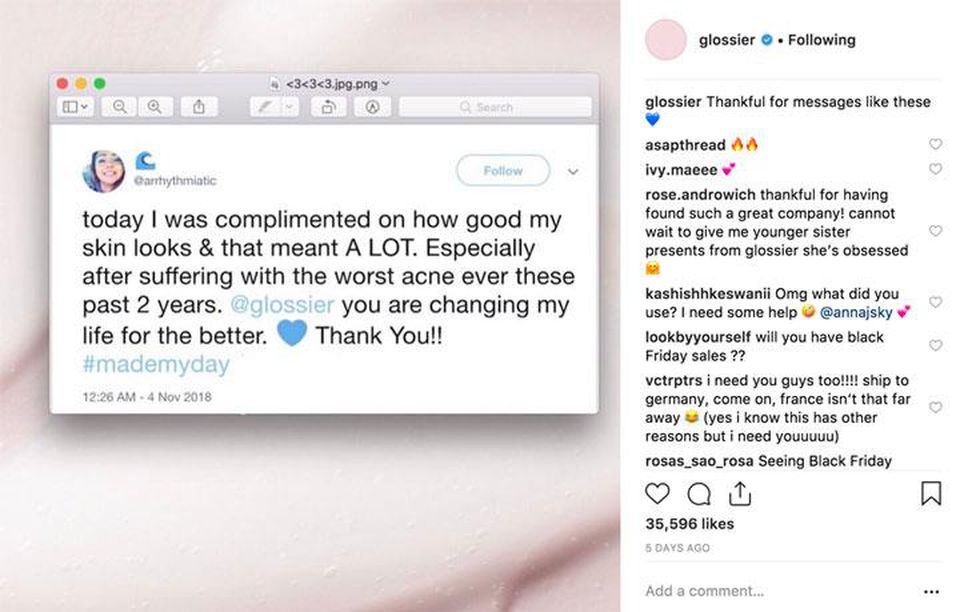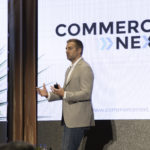ARTICLE SUMMARY:
There’s no easy, step-by-step manual for starting a direct-to-consumer brand in this ecommerce age of Amazon. But Glossier seems to have faced little trouble figuring out how to sprint to the top of the beauty market and amass a customer following only household name brands traditionally experience.
Co-creating every product with its customers, Glossier shaped its strategy, brand and social community right along side its target audience. The beauty brand doesn’t put expensive ad campaigns at the core of its marketing strategy, like many of its competitors. It builds both online and store experiences, as well as internal teams and tactics entirely around its customer needs, feedback and general practices around beauty.
Then comes measuring the results. Glossier values connection with the customer above all, and correlates the volume of connection fostered throughout its online and offline communities directly to purchasing behavior. Word-of-mouth and direct engagement, whether it be online through comments or in a pop-up store with a store “editor”, are the strongest sources and indicators of growth for Glossier.
Beauty isn’t just an industry to Glossier—rather, it’s a conversation and a collection of beliefs and lifestyles that connects customers. Not only has Glossier become part of that conversation, they’ve also leveraged beauty-enthusiasts to help them grow the brand and guide its substantial success.
Ali Weiss, Glossier’s SVP of Marketing, is the brains behind this brand strategy beauty. She took CommerceNext co-founder, Veronika Sonsev, through the Glossier marketing experience. Read the whole interview below.
This article was originally published in Forbes: Why Glossier Takes Marketing Risks To Delight Their Customer. You can also dig in deeper by reading the full article below.
Direct-to-consumer beauty brand Glossier boasts a highly devoted customer following. If last year’s 300% growth isn’t enough to convince you, just look at its 1.6MM Instagram followers or the long lines of customers waiting outside one of Glossier’s stores or pop-up shops.
This demand wasn’t generated from common retail industry ploys like massive advertising spends or offering discounts and special promotions. Glossier’s customers line up daily because they feel like the company was created just for them, by them, and they want to be part of the story.
Everything from Glossier’s products to their marketing was essentially co-created with the customer. Even new products are developed from feedback in social comments and engaging customers in a discussion about their beauty needs.
To implement this deeply customer-centric approach, Glossier couldn’t borrow from standard marketing tactics. It took risks and built marketing from the ground up so the customer’s voice remained the focus of everything it does. Glossier’s new NY flagship store embodies this philosophy. The store doesn’t contain a cash wrap or shelves stocked with products to instead encourage product discovery, connection and magic.

Glossier’s SVP of Marketing, Ali Weiss, didn’t come from a traditional marketing background or with an existing marketing playbook in hand. She built out Glossier’s marketing team and strategy by understanding the customer and taking calculated risks to give Glossier the edge. Weiss recently talked me through her unconventional approach to marketing, which focuses on customer engagement more than bottom-line results.
Ali Weiss, SVP of Marketing at Glossier, Courtesy of Glossier
Veronika Sonsev: How did you lay the foundation for Glossier’s pioneering marketing strategy and determine where to invest time and resources?
Ali Weiss: Everything that we do is driven by our devotion to putting the customer first. This impacts the choices we make when it comes to product packaging, which stores we open, video ads and social media posts.
Since Glossier is a new brand, we had the privilege of building a holistic marketing and product approach from scratch. We were able to test, learn and scale our structure and processes with the customer as our “true north.”
We established five key pillars of the team:
- Product Marketing and Development defines what products we create, how we collaborate with our community to discover opportunities in the portfolio, key messages we market, and key ingredients and product attributes consumers want.
- Brand Marketing includes our own social and overall brand strategies, and go-to-market planning.
- Performance Marketing covers everything we do on our paid media channels. They mainly focus on digital, but also on certain things offline.
- Customer Experience Team (gTeam) embodies the heart and soul of our company and the eyes and ears of the brand. They constantly collect feedback from our community of customers and assume responsibility for creating the best experience possible with the brand.
- Stores oversee both the permanent locations and pop-ups.
At Glossier, product development is integrated into marketing. It’s part of our holistic approach to making sure the customer’s voice is heard. As we scale, the company has built a structure to keep the customer front and center.
Sonsev: How do you balance brand and performance marketing objectives?
Weiss: Everything we create aims to cultivate an active community of conversation and connection. We firmly believe that strategy ultimately leads to transactions.
We do also measure quantitative results. If our content and products are engaging for her and for her friends, we have been able to prove out downstream business success in terms of product purchases. We are able to demonstrate how social engagement correlates with the lifetime value of the customer.

Sonsev: What key performance indicators do you measure to determine the success or failure of a marketing program?
Weiss: Our business model relies on selling products, but revenue growth and acquiring new customers are secondary to our mission of giving voice to beauty. We focus on experience first and business results second.
We see beauty as a powerful conduit for connection, and connection became our competitive advantage — 72% of millennials take product recommendations through content on Instagram and 70% of sales come from word-of-mouth organic connections.
We monitor where sales originate — social, stores or organic — and try to understand why. We also measure how many conversations both our gTeam editors and showroom editors engage in. If those metrics are strong, we know business results will follow.
Sonsev: As you go into physical retail with the opening of your new NY flagship store, are you taking a test and learn approach?
Weiss: We don’t think of retail as a massive growth channel for us, nor as a place for experimentation. It’s about putting down roots in NY and LA, as well as some temporary locations in other places.
The retail stores are a calculated, true representation of the Glossier brand and what the experience should be. We definitely take risks, but we analyze how it will impact the consumer experience before we do anything.

In our NY flagship store, there is no stationary place for transactions. Our customers come to get lost in an experience, trial and conversation. The showroom editors offer peer-to-peer recommendations. When you’re ready to buy, editors check you out on an iPad wherever you may be in the store. The product is then delivered from the sky via a conveyor belt. It’s a magical experience.
It takes an unconventional approach to build a customer-centric beauty brand like Glossier. Glossier has taken some risks to chart their own course and that seems to be paying off with complete customer devotion.
For more relevant customer acquisition and digital marketing tactics, subscribe to the CommerceNext YouTube channel and see almost every session from our 2018 summer summit.
Sign up for our newsletter and join us at the retail and ecommerce conference of the summer, CommerceNext 2019 in NYC, to see digital marketing leaders live.
Related Posts
-
How Retailers And Direct to Consumer Brands Are Investing In Marketing This Holiday Season
The holiday shopping season is upon us. Last year, we…
-
Customer Experience and Community as the Ultimate Marketing Tool
If you spend time online, you’ve undoubtedly heard of cult-favorite…
-
Connecting Cause Marketing with Brand Mission for Good
Consumers are looking for a cause. Sixty-four percent of consumers…




